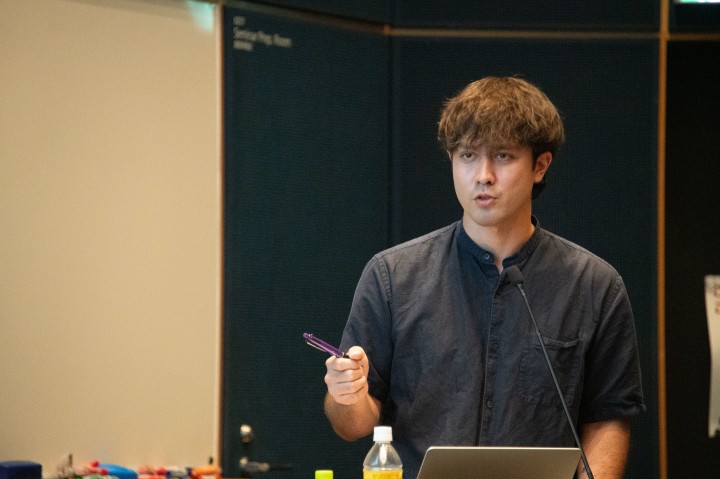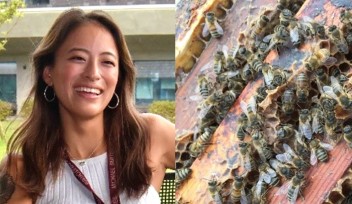Column: Why become a scientist?
The latest OIST column in the Asahi Shimbun GLOBE+ is out now! This month, Rahel Collyer-Hoar spoke to fellow PhD student Sutashu Tomonaga about his path to becoming a scientist. The article is in Japanese, but the original English version can be read below.
Choosing to become a scientist can be daunting, while the work is often exceptionally interesting, this career also comes with its own unique challenges such as long training and unclear job perspectives. So why should somebody choose this rewarding but challenging path? This year's Science and Technology Week, dedicated as such by MEXT and a yearly occurrence from the 15th to the 21st of April, offered me an opportunity to introduce a fellow scientist and his path to becoming a scientist.
I am a fourth-year PhD student myself and my reasons for entering PhD were quite pragmatic. I decided to enroll in a doctoral program because my scientific curiosity had not yet been satisfied after my master’s degree but also because I was attracted to the OIST program and the exciting opportunity to gain experience living in Japan. But I was curious to find out how other PhD candidates made their career decisions, a topic I spoke about with OIST student Sutashu Tomonaga.
Sutashu, who grew up in Okinawa, is a PhD candidate in the Neural Computation Unit and a member of the Student Council. “I am an island boy and nobody in my family is a scientist. My sister and I were the first to attend graduate school,” he says. When Sutashu got interested in science as a small child, his parents did their best to support him in discovering the world of science. “My parents bought me books and signed me up for the OIST’s open campus when I was in 5th grade. But they were also worried about my job perspective and financial security if aimed for a career in science,” he remembers.
From this early age on, Sutashu was especially interested in physics and looked up to Nobel laureates he saw on TV. Even before starting high school, he set the goal for himself to become a physicist; “Scientists and Nobel laureates were something you would only see on TV, I never expected to one day be associated with people like them.” With this early resolution, the child of an American father and an Okinawan mother benefited from growing up bilingual. “I did well in math and physics, but my average score was often dominated by my English grades,” Sutashu remembers.

After graduating from high school, Sutashu succeeded in obtaining a spot at the prestigious Waseda University in Tokyo. While this was a reason to celebrate, he also experienced a harsh personal setback at the same time - when failing to be accepted into the university's physics department. With this childhood dream in jeopardy, he was faced with a choice.
He either had to switch fields or wait a year and retake the exam to enter the physics department. Eventually, Sutashu decided on the first option and began his studies at the Department of Electrical Engineering in Bioscience. “At the beginning, I was very unhappy. I had said to everyone for 10 years that I would become a physicist and suddenly this was over,” Sutashu says. Despite his initial disappointment he dedicated himself to his undergraduate studies and discovered his interest in machine learning, a field with strong connections to physics. But some doubts remained, which could neither be erased by the joy the research in machine learning brought nor his curiosity to find answers to the scientific questions he worked on, “I was wondering if it was me who had to do this work? Is this my purpose?” Sutashu recalls.
In 2019, during his last year of bachelor’s studies, those questions led him to return to Okinawa and the university he had known since elementary school. “I really wanted to try doing research in physics and with an OIST internship that was possible. Also, at OIST I had for the first time the chance to work closely with experienced scientists and researchers,” Sutashu says. For his internship, he joined the Mechanics and Materials Unit and began working on Möbius Kaleidocycles, an interesting but also very theoretical task. It was not until the beginning of the COVID-19 emergency in the following year that he found his true passion in science after overcoming another major challenge.
With the pandemic, Sutashu had slid into a personal crisis. “This was a very difficult time, I realized that I repeated behavioral patterns I criticized in others in my relationships. This was when I started to read literature about psychology, behavioral therapy, emotional regulations, and behavioral genetics. And at first, this was very scary!” he explains.
Wanting to know even more about this topic, he decided to pursue his own research at the intersection of psychology, neuroscience and machine learning. After having enrolled in OIST’s doctoral program, he spent his first year as a PhD student expanding his professional horizon. He completed rotations in labs working on neuroscience, artificial intelligence and cognitive science. Eventually, Sutashu turned his personal interest into scientific purpose when he joined the Neural Computation Unit where he began his thesis work focused on the use of machine learning to optimize mental health.
By diving deep into this subject, he found inspiration for both his career and personal life. “The more purpose you have, the less anxiety you will experience about small actions,” Sutashu explains before giving an example of how this thought had helped him to become a better scientist. “I really liked physics and read a lot of related books, but I had never thought about why I wanted to become a physicist, I simply thought it would be cool. This is why failing my exam to enter the physics department left me in an existential crisis. Doing physics had become my purpose for living and suddenly this was gone. But if you read the same books because you want to solve a specific problem, it doesn’t matter if you fail to remember all the information. You can always read it again or just pick another book. In this case, studying is only a means to an end, to achieve a higher goal,” Sutashu says.
The desire to help himself and others who might experience similar struggles with their mental health still is the driving force behind his scientific work. Today, Sutashu is developing novel mathematical models that can make assumptions based on the highly variable data that wearable devices produce.
These devices, for example smart watches or rings with integrated sensors, can track health metrics in real-time and over a long time. Best known are such devices for recording heart rate or tracking our sleep but this technology is evolving quickly and might in the future be able to track much more, including the mental health state of the wearer. But the data these devices produce cannot be suitably analyzed with current mathematical models, as those were developed based on traditional data sets.
Sutashu explains the need for new models at the example of heart rate measurements: “If you measure the heart rate in the lab, with a patient in a resting state, there is much less noise in the data. Additionally, for practical reasons, these measurements were highly time constraint, usually only between 15 minutes to a few hours.” This very consistent data collected during a short time is not ideal to represent people’s physiological state in their everyday lives.
A gap that wearable devices can fill by measuring data while people go about their normal lives. But longer measurements come with new constraints that need to be addressed. If people forget to wear their device for example or the battery runs out, the data has gaps. A mathematical model used to interpret this data therefore must take other factors into account than a model used on traditional data, such as the higher variability in the data or unexpected gaps in otherwise long continuous recordings.

By identifying these conditions during data collection and building a model considering them, the resulting model could be used and adapted for any data set that shared these basic conditions when it was created. Building this new mathematical model is the goal of Sutashu’s thesis work, “in the future, this will hopefully contribute to helping people, including myself, to take better care of their health and to alleviate suffering,” he says.
And his desire to help expands beyond research alone. “I made the experience, that I grow most when I have responsibilities,” explains Sutashu who was repeatedly elected to OIST’s Student Council. Like many other Universities, OIST has a way to allow their members to participate in the decision-making processes. The current student body of 287 people is represented by this Student Council, which has 19 elected members. “Our role is to convey information and wishes from the students as transparently as possible,” explains Sutashu.
During his time as chair of the Student Council, it was his initiative that allowed an event to be established where students and researchers could meet in person with OIST’s Board of Govenors, the committee overseeing the university. During this meeting, Sutashu got a chance to directly address the Board of Govenors members which include roughly twenty highly distinguished personalities, including Nobel laureates, business leaders and university administrators. This meeting was so successful for all parties involved that it is planned to keep it as a regular platform to allow for an even better exchange between students and the university’s leadership. This meeting also marked a moment representing that Sutashu Tomonaga has found his place in science and is well on the path to becoming the best version of himself.
Specialties














